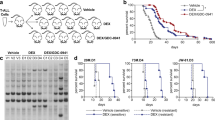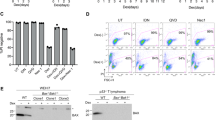Abstract
Due to their growth arrest- and apoptosis-inducing ability, glucocorticoids (GC) are widely used in the therapy of various lymphoid malignancies. The signal transduction pathways leading to this clinically-relevant form of apoptosis have, however, not been sufficiently elucidated. GC bind to their specific receptor, a ligand-activated transcription factor of the Zn-finger type, that activates or represses transcription of GC-responsive genes. Previous studies in leukemia cells suggested that transcriptional repression of c-myc expression might be the crucial event in GC-induced apoptosis, although in other systems, c-Myc apparently increased the sensitivity to cell-death inducers. To address this controversy, we stably transfected the GC-sensitive human T-ALL cell line CEM-C7H2 with constructs allowing tetracycline-regulated expression of c-Myc. Subsequent analyses of these cell lines showed that overexpression of c-Myc per se had little, if any, effect on cell viability, although it rendered the cells more sensitive to apoptosis induced by low serum, confirming the functionality of the expressed transgene. More importantly, however, when the cells were treated with GC in the presence of exogenous c-Myc, they underwent apoptosis exceeding that in cells treated in the absence of transgenic c-Myc. The data indicate that c-myc downregulation is not critical for induction of cell-death by GC in this system, and support the notion that c-Myc sensitizes cells to apoptosis-inducing agents.
This is a preview of subscription content, access via your institution
Access options
Subscribe to this journal
Receive 50 print issues and online access
$259.00 per year
only $5.18 per issue
Buy this article
- Purchase on Springer Link
- Instant access to full article PDF
Prices may be subject to local taxes which are calculated during checkout



Similar content being viewed by others
Abbreviations
- GC:
-
glucocorticoid(s)
- GR:
-
glucocorticoid receptor
- rtTA:
-
reverse tetracycline-controllable synthetic transcription factor
References
Ashraf J and Thompson EB. . 1993 Mol. Endocrinol. 7: 631–642.
Askew DS, Ashmun RA, Simmons BC and Cleveland JL. . 1991 Oncogene 6: 1915–1922.
Bissonnette RP, McGahon A, Mahboubi A and Green DR. . 1994 J. Exp. Med. 180: 2413–2418.
Blochlinger K and Diggelmann H. . 1984 Mol. Cell. Biol. 4: 2929–2931.
Chapman MS, Askew DJ, Kuscuoglu U and Miesfeld RL. . 1996 Mol. Endocrinol. 10: 967–978.
Chen C, Nussenzweig A, Guo M, Kim D, Li GC and Ling CC. . 1994 Radiat. Res. 139: 307–315.
Cowan NJ, Dobner PR, Fuchs EV and Cleveland DW. . 1983 Mol. Cell. Biol. 3: 1738–1745.
Dong JA, Naito M and Tsuruo T. . 1997 Oncogene 15: 639–647.
Eilers M, Picard D, Yamamoto KR and Bishop JM. . 1989 Nature 340: 66–68.
Evan G. . 1997 Int J Cancer 71: 709–711.
Evan GI, Wyllie AH, Gilbert CS, Littlewood TD, Land H, Brooks M, Waters CM, Penn LZ and Hancock DC. . 1992 Cell 69: 119–128.
Fanidi A, Harrington EA and Evan GI. . 1992 Nature 359: 554–556.
Geley S, Fiegl M, Hartmann BL and Kofler R. . 1996a Rev. Physiol. Biochem. P. 128: 1–97.
Geley S, Hartmann BL, Hala M, Strasser-Wozak EMC, Kapelari K and Kofler R. . 1996b Cancer Res. 56: 5033–5038.
Geley S, Hartmann BL, Hattmannstorfer R, Löffler M, Ausserlechner MJ, Bernhard D, Sgonc R, Strasser-Wozak EMC, Ebner M, Auer B and Kofler R. . 1997a Oncogene 15: 2429–2437.
Geley S, Hartmann BL, Kapelari K, Egle A, Villunger A, Heidacher D, Greil R, Auer B and Kofler R. . 1997b FEBS Lett. 402: 36–40.
Gossen M and Bujard H. . 1992 Proc. Natl. Acad. Sci. USA 89: 5547–5551.
Grandori C and Eisenman RN. . 1997 Trends Biochem. Sci. 22: 177–181.
Hala M, Hartmann BL, Böck G, Geley S and Kofler R. . 1996 Int. J. Cancer. 68: 663–668.
Han JW, Dionne CA, Kedersha NL and Goldmacher VS. . 1997 Cancer Res. 57: 176–182.
Hartmann BL, Gerley S, Löffler M, Hattmannstorfer R, Strasser-Wozak EMC, Auer B and Kofler R. . 1998 Oncogene 17: in press.
Helmberg A, Auphan N, Caelles C and Karin M. . 1995 EMBO J. 14: 452–460.
Hueber AO, Zörnig M, Lyon D, Suda T, Nagata S and Evan GI. . 1997 Science 278: 1305–1309.
Jänicke RU, Lee FHH and Porter AG. . 1994 Mol. Cell. Biol. 14: 5661–5670.
Kaptein JS, Lin CKE, Wang CL, Nguyen TT, Kalunta CI, Park E, Chen FS and Lad PM. . 1996 J. Biol. Chem. 271: 18875–18884.
Katoh K, Takahashi Y, Hayashi S and Kondoh H. . 1987 Cell. Struct. Funct. 12: 575–580.
Klefstrom J, Västrick I, Saksela E, Valle J, Eilers M and Alitalo K. . 1994 EMBO J. 13: 5442–5450.
Ma T, Mahajan PB and Thompson EA. . 1992 Mol. Endocrinol. 6: 960–968.
Miyazaki J, Takaki S, Araki K, Tashiro F, Tominaga A, Takatsu K and Yamamura K. . 1989 Gene 79: 269–277.
Nicoletti I, Migliorati G, Pagliacci MC, Grignani F and Riccardi C. . 1991 J. Immunol. Methods 139: 271–279.
Powers JH, Hillmann AG, Tang DC and Harmon JM. . 1993 Cancer Res. 53: 4059–4065.
Rhee K, Bresnahan W, Hirai A, Hirai M and Thompson EA. . 1995 Cancer Res. 55: 4188–4195.
Schwartzman RA and Cidlowski JA. . 1994 Int. Arch. Allergy Immunol. 105: 347–354.
Selvakumaran M, Lin H-K, Tjin Tham Sjin R, Reed JC, Liebermann DA and Hoffman B. . 1994 Mol. Cell. Biol. 14: 2352–2360.
Sgonc R and Wick G. . 1994 Int. Arch. Allergy Immunol. 105: 327–332.
Shi Y, Glynn JM, Guilbert LJ, Cotter TG, Bissonnette RP and Green DR. . 1992 Science 257: 212–214.
Strasser-Wozak EMC, Hattmannstorfer R, Hála M, Hartmann BL, Fiegl M, Geley S and Kofler R. . 1995 Cancer Res. 55: 348–353.
Thompson EB. . 1994 Mol. Endocrinol. 8: 665–673.
Thulasi R, Harbour DV and Thompson EB. . 1993 J. Biol. Chem. 268: 18306–18312.
Wood AC, Waters CM, Garner A and Hickman JA. . 1994 Br. J. Cancer 69: 663–669.
Yuh Y-S and Thompson EB. . 1989 J. Biol. Chem. 264: 10904–10910.
Zindy F, Eischen CM, Randle DH, Kamijo T, Cleveland JL, Sherr CJ and Roussel MF. . 1998 Genes Dev. 12: 2424–2433.
Acknowledgements
The authors thank Drs H Bujard, W Doppler, M Eilers and V Gagliardini for donating vectors, I Jaklitsch and S Lobenwein for technical assistance and M Kat Occhipinti for editing the manuscript. Supported by grants from the Austrian National Bank (ÖNB-6156) and the Austrian Science Foundation (SFB-F204, P-11946 and P11306).
Author information
Authors and Affiliations
Rights and permissions
About this article
Cite this article
Löffler, M., Ausserlechner, M., Tonko, M. et al. c-Myc does not prevent glucocorticoid-induced apoptosis of human leukemic lymphoblasts. Oncogene 18, 4626–4631 (1999). https://doi.org/10.1038/sj.onc.1202820
Received:
Revised:
Accepted:
Published:
Issue Date:
DOI: https://doi.org/10.1038/sj.onc.1202820
Keywords
This article is cited by
-
Erg and AP-1 as determinants of glucocorticoid response in acute lymphoblastic leukemia
Oncogene (2013)
-
Expression, regulation and function of phosphofructo-kinase/fructose-biphosphatases (PFKFBs) in glucocorticoid-induced apoptosis of acute lymphoblastic leukemia cells
BMC Cancer (2010)
-
Repression of the BH3-only molecule PMAIP1/Noxa impairs glucocorticoid sensitivity of acute lymphoblastic leukemia cells
Apoptosis (2009)
-
The BCL2 rheostat in glucocorticoid-induced apoptosis of acute lymphoblastic leukemia
Leukemia (2008)
-
Cyclin D3 and c-MYC control glucocorticoid-induced cell cycle arrest but not apoptosis in lymphoblastic leukemia cells
Cell Death & Differentiation (2004)



